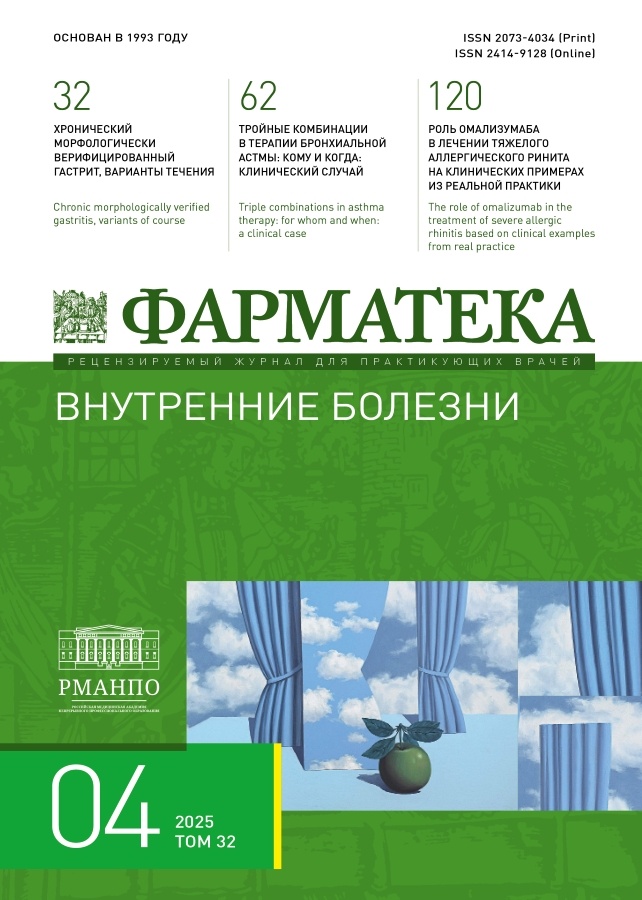Modern view on the function of Hassall’s corpuscles
- Authors: Sidnyaev V.A.1, Svishcheva M.V.1, Volkova L.V.1, Vvedenskaya O.Y.1, Gerbig N.A.1, Kuznetsova M.A.1
-
Affiliations:
- Moscow University “Synergy”
- Issue: Vol 32, No 4 (2025)
- Pages: 54-61
- Section: Pulmonology/ENT/ARVI
- URL: https://journals.eco-vector.com/2073-4034/article/view/687704
- DOI: https://doi.org/10.18565/pharmateca.2025.4.54-61
- ID: 687704
Cite item
Abstract
Hassall’s corpuscles are unique epithelial structures of the thymus medulla. Despite the long history of thymic corpuscle research, their functions and structural features still require further study. This review analyzes modern literature data on the structure, origin, and functional role of Hassall’s corpuscles in health and various pathologies. It is shown that the main structural component of the corpuscles are medullary thymic epithelial cells (mTEC) at the terminal stages of differentiation, which undergo keratinization similar to epidermal cells. In addition to mTEC, the bodies include microenvironment cells: dendritic cells, macrophages, myoid cells, and lymphocytes. Modern studies using single-cell RNA sequencing and spatial transcriptomics have shown that «aging» mTEC of Hassall’s corpuscles produce a wide range of cytokines, chemokines, and antimicrobial peptides, forming a specific proinflammatory microenvironment of the thymus medulla. The interaction of secreted factors with cells of innate and adaptive immunity plays an important role in the processes of negative selection of autoreactive thymocytes and differentiation of regulatory T-lymphocytes. Structural and functional changes in Hassall’s corpuscles observed in age-related thymus involution and various pathological conditions can lead to a violation of central immunological tolerance and the development of autoimmune diseases. Thus, Hassall’s corpuscles are not only morphological markers of thymus involution, but also functionally active structures involved in maintaining thymic homeostasis. Further studies of the molecular mechanisms that control the morphogenesis and activity of Hassall’s corpuscles may open up new possibilities for developing approaches to correcting age-related changes in the immune system.
Full Text
About the authors
Vitaly A. Sidnyaev
Moscow University “Synergy”
Author for correspondence.
Email: vitaliysidnyaev@mail.ru
ORCID iD: 0009-0002-5327-7794
Clinical Psychologist, Student of the Faculty of Medicine
Russian Federation, MoscowMaria V. Svishcheva
Moscow University “Synergy”
Email: mascha.svisheva@yandex.ru
ORCID iD: 0000-0001-9825-1139
Cand. Sci. (Med.), Associate Professor, Department of Medical and Biological Disciplines, Faculty of Medicine
Russian Federation, MoscowLarisa V. Volkova
Moscow University “Synergy”
Email: volkovalr16@gmail.com
ORCID iD: 0000-0003-0938-8577
Dr.Sci. (Med.), Professor, Department of Medical and Biological Disciplines, Faculty of Medicine
Russian Federation, MoscowOlga Yu. Vvedenskaya
Moscow University “Synergy”
Email: olga.vwedensckaya@yandex.ru
ORCID iD: 0000-0001-7808-269X
Cand. Sci. (Med.), Associate Professor, Department of Medical and Biological Disciplines, Faculty of Medicine
Russian Federation, MoscowNatalia A. Gerbig
Moscow University “Synergy”
Email: nataliagerbig@gmail.com
ORCID iD: 0009-0005-2748-2630
Student, Faculty of Medicine
Russian Federation, MoscowMaria A. Kuznetsova
Moscow University “Synergy”
Email: Aelaya@hotmail.com
Cand. Sci. (Med.), Associate Professor, Department of Medical and Biological Disciplines, Faculty of Medicine
Russian Federation, MoscowReferences
- Kater L.A Note on Hassall’s Corpuscles. Contemporary Topics in Immunobiology. 1972;2:101–109. https://doi.org/10.1007/978-1-4684-0919-2_6
- Карабаев А.Г. Взаимосвязь реактивности вегетативной нервной системы и морфофункциональной активности базофильных клеток аденогипофиза в постреанимационном периоде. Наука и мир. 2020;3:79. [Karabayev A.G. The relationship between the reactivity of the autonomic nervous system and the morphofunctional activity of basophilic cells of the adenohypophysis in the post-resuscitation period. Science and World. 2020;3:79. (In Russ.)].
- Marinova T.Ts., Spassov L.D., Vlassov V.I., et al. Aged Human Thymus Hassall’s Corpuscles Are Immunoreactive for IGF-I and IGF-I Receptor. The Anatomical Record. 2009;292(6):837–841. https://doi.org/10.1002/ar.20920
- Wang J., Sekai M., Matsui T., et al. Hassall’s corpuscles with cellular-senescence features maintain IFNα production through neutrophils and pDC activation in the thymus. Int Immunol. 2018;31(3):127–139. https://doi.org/10.1093/intimm/dxy073
- Watanabe N., Wang Y.-H., Lee H.K., et al. Hassall’s corpuscles instruct dendritic cells to induce CD4+CD25+ regulatory T cells in human thymus. Nature. 2005;436(7054):1181–1185. https://doi.org/10.1038/nature03886
- Yang X., Chen X., Wang W., et al. Transcriptional profile of human thymus reveals IGFBP5 is correlated with age-related thymic involution. Front Immunol. 2024;15:1322214. https://doi.org/10.3389/fimmu.2024.1322214
- Park J.E., Botting R.A., Dominguez Conde C., et al. A cell atlas of human thymic development defines T cell repertoire formation. Science. 2020;367(6480):eaay3224. https://doi.org/10.1126/science.aay3224
- Symmank D., Richter F.C., Rendeiro A.F. Navigating the thymic landscape through development: from cellular atlas to tissue cartography. Genes & Immunity. 2024;25:102–104.
- Аблякимов Э.Т., Кривенцов М.А. Функции телец Гассаля и их связь с микроокружением. Научно-методический электронный журнал «Концепт». 2017;42:112–115. Ablyakimov E.T., Kriventsov MA. Functions of Hassall’s corpuscles and their relationship with the microenvironment. Scientific and Methodological Electronic Journal “Concept”. 2017;42:112–115. (In Russ.)].
- Aschenbrenner K., D’Cruz L.M., Vollmann E.H., et al. Selection of Foxp3+ regulatory T cells specific for self antigen expressed and presented by Aire+ medullary thymic epithelial cells. Nature Immunol. 2007;8(4):351–358. https://doi.org/10.1038/ni1444
- Berrih-Aknin S., Panse R.L., & Dragin N. AIRE: a missing link to explain female susceptibility to autoimmune diseases. Ann New York Acad Sci. 2017;1412(1):21–32. https://doi.org/10.1111/nyas.13529
- Klein L., Petrozziello E. Antigen presentation for central tolerance induction. Nature Reviews Immunology. 2025;25(1):57–72. https://doi.org/10.1038/s41577-024-01076-8
- Mudrak D.A., Navolokin N.A., Maslyakova G.N. Morphology of Hassall’s corpuscles and their microenvironment in neonates with increased thymus weight. Arkhiv patologii. 2024;86(1):13–20. https://doi.org/10.17116/patol20248601113
- Омельчук Н.Н., Волкова Л.В., Бондарев В.П. Циклические изменения тимических телец при гиперплазии тимуса. Успехи современного естествознания. 2014;10:15–15. [Omelchuk N.N., Volkova L.V., Bondarev V.P. Cyclical changes of thymic corpuscles in thymus hyperplasia. Advances in Modern Natural Science. 2014;10:15–15. (In Russ.)].
- Suster D., & Suster S. Chapter 5. Thymus and Mediastinum. In: Gattuso’s Differential Diagnosis in Surgical Pathology (Fourth Edition). Elsevier, 2022. P. 279–305. https://doi.org/10.1016/B978-0-323-66165-2.00005-3
- Беловешкин А.Г. Роль телец Гассаля тимуса человека в позитивной и негативной селекции тимоцитов. Молодой ученый. 2012;7(42):334–338. [Beloveshkin A.G. The role of human thymus Hassall’s corpuscles in positive and negative selection of thymocytes. Young Scientist. 2012;7(42):334–338. (In Russ.)].
- Зияев Ш.А. Патоморфологическая характеристика тимуса при сепсисе у детей. Re-health journal. 2023;3(19). Ziyaev Sh.A. Pathomorphological characteristics of the thymus in sepsis in children. Re-health journal. 2023;3(19). (In Russ.)].
- Коржавов Ш.О., Исмоилов О.И., Султанбаев Ш.А. Морфологическое строение тимуса у новорожденных с врожденной различной вирусной инфекцией. Центрально-азиатский медицинский и естественнонаучный журнал. 2023;4(5):527–534. [Korzhavov Sh.O., Ismoilov O.I., Sultanbaev Sh.A. Morphological structure of the thymus in newborns with various congenital viral infections. Central Asian Medical and Natural Science Journal. 2023;4(5):527–534. (In Russ.)].
Supplementary files








